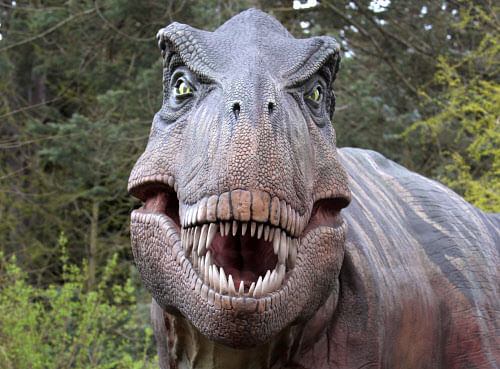
Scientists have discovered a fossilised tooth belonging to the vicious Tyrannosaurus rex dinosaur, which they claim provides solid evidence that the creature was indeed a predator, hunter and killer, and not a scavenger as some paleontologists have suggested.
T rex has long been popular as the most notorious, vicious killing creature to roam the planet during the age of the dinosaurs. However, for more than a century some paleontologists have argued that T rex was a scavenger, not a true predator - more like a vulture than a lion.
"T rex is the monster of our dreams," said David Burnham, preparator of vertebrate paleontology at the Biodiversity Institute at the University of Kansas.
"But ever since it was discovered in Montana and named in the early 1900s, there's been a debate about whether these large carnivores were scavengers or predators.
"Most people assume they were predators, but the scientific evidence for predation has been really elusive. Yes, we've found lots of dinosaur skeletons with tooth marks that had been chewed up by something.
"But what did that really prove? Yes, these large carnivores fed on other dinosaurs - but did they eat them while they were alive or dead? That's where the debate came in. Where was the evidence for hunt and kill?" Burnham said.
Now, Burnham and his team have unearthed physical proof that T rex was indeed a predator, hunter and killer. In the Hell Creek Formation of South Dakota, Burnham and colleagues discovered the crown of a T rex tooth lodged in the fossilised spine of a plant-eating hadrosaur that seems to have survived the attack.
Previous evidence for predation included T rex fossil discoveries with preserved stomach contents that included the bones of a young ceratopsian (eg, Triceratops or one of its kin).
However, there was no evidence to conclude whether the ceratopsian was alive or dead when the T rex made a snack of it.
By contrast, Burnham said the tooth was definitive evidence of hunting, after carefully measuring its length and the size of its serrations to ensure that it came from the mouth of a T rex.
"Lo and behold, the tooth plotted out just exactly with T rex - the only known large theropod from the Hell Creek formation," Burnham said.
"We knew we had a T rex tooth in the tail of a hadrosaur. Better yet, we knew the hadrosaur got away because the bone had begun to heal.
"Quite possibly it was being pursued by the T rex when it was bitten. It was going in the right direction - away. The hadrosaur escaped by some stroke of luck," he said.
The team describes the find in the journal Proceedings of the National Academy of Sciences.
Deccan Herald is on WhatsApp Channels| Join now for Breaking News & Editor's Picks